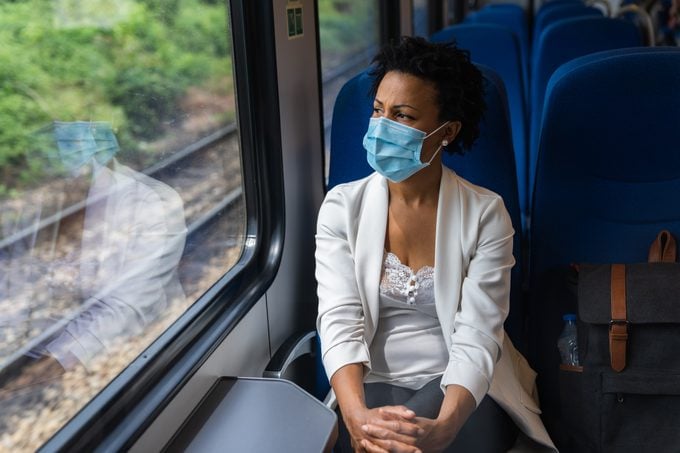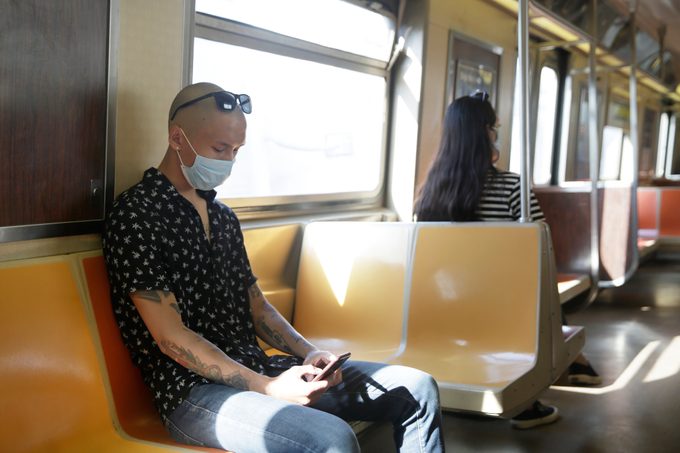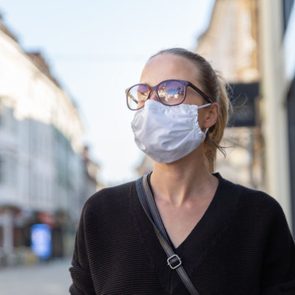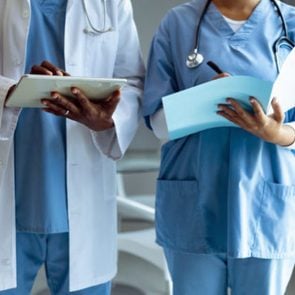How Can I Avoid Catching Coronavirus on Public Transportation?
Updated: Mar. 03, 2021
Precautions like wearing a face mask and maintaining physical distance can help reduce your risk of catching coronavirus on public transit.
Millions of Americans depended on public transportation to get around before the Covid-19 pandemic. According to the American Public Transportation Association, people boarded public transportation 34 million times each weekday, pre-Covid-19. Although many people stopped or reduced their use of mass transit while quarantined, now that lockdowns are being lifted and people are returning to their workplace, could subways, trains, and buses become hot spots for catching coronavirus? The research shows it’s possible to avoid this—if we take precautions. Of course, if you’re at high risk for coronavirus, talk to your employer about whether it’s possible to continue to work from home.

Public transit and the risk of catching coronavirus
An April 2020 report in The National Bureau of Economic Research by an MIT economist, Jeffrey E. Harris, suggested that the transit system was behind New York City’s Covid-19 outbreak. However, Harris’ research was not peer-reviewed and was criticized as scientifically flawed. One of the many reasons included its failure to actually trace an individual case where one person was infected because they shared a subway ride with someone who was presumably Covid-19 positive. (Read about a day-in-the-life of a Covid-19 contact tracer.)
Since then, science has not found public transportation to be a major source of catching coronavirus. For example, a June 2020 report from Santé Publique France, France’s national public health agency, found of the 150 clusters of cases reported between early May and early June, none appeared to be linked to public transportation. Meanwhile, public health officials in Japan who traced clusters also did not find them linked to public transportation. But, keep in mind this doesn’t mean the virus isn’t present on trains and buses—it just means there may be effective means to avoid catching it.
Put your face mask on
Most importantly, “wear your mask,” says Suzanne Willard, clinical professor and associate dean of global health at the Rutgers School of Nursing in New Brunswick, New Jersey. “Understand that the virus is still among us, protection works, and we need to use it and be cautious. It is important that as we see more people around we should not be complacent that the virus has gone away.” Masks prevent respiratory droplets from being expelled and infecting others when a person talks, coughs, or sneezes, which, according to the Centers for Disease Control and Prevention (CDC), is the main way the virus is transmitted.
In a June 2020 review in the journal The Lancet, face masks, specifically N95 or similar respirators, were found to be effective at preventing virus transmission. And on some mass transit systems, such as New York City’s, masks are required. (Although, N95s should be reserved for healthcare workers. Transmission is still preventable with other types of face masks.) If you normally used your train time to scarf down breakfast or have a coffee, that would obviously require removing your mask, so it’s also best to avoid eating or drinking until you’re at your destination to avoid getting sick. (Need a face mask? Here’s how to make your own face mask for coronavirus protection and face masks you can buy that are good for exercise or during hot weather.)
Consider eye protection
The previously mentioned Lancet study also found that eye protection, such as goggles or a face shield, worked to reduce the risk of catching coronavirus. The CDC says through the eyes is “possibly” a way to get Covid-19. What about gloves? “Gloves work, but hand washing [is important] when you get to your destination,” Willard says. Gloves are effective only if you don’t touch your face: It’s not the virus getting on your skin that makes you sick, but touching your mouth, nose, or eyes with contaminated hands—whether you’re wearing gloves or not.
You also need to take gloves off correctly to avoid contaminating yourself; and you still need to wash your hands when you get to where you’re going. If you’ve touched your cell phone in transit, wipe that down as well. (Here’s the right way to disinfect your phone to kill coronavirus.)
Try not to touch surfaces (or your face)
Whether you’re wearing gloves or not, be careful where your hands go as soon as you enter the station. A secondary way to get sick? “Touching surfaces others have touched,” Willard says. Some transit authorities are introducing contactless fare payment, like New York’s new OMNY system, so you can avoid the ticket machines.
Many transit systems, like New York’s, are implementing more stringent cleaning methods and experimenting with new ways of sanitizing, like using UV light. Still, push turnstiles with your hip instead of your hand (wash your clothes when you get home), and if you must hold a strap or pole to keep your balance once onboard—you certainly don’t want to be falling into anyone—be aware not to touch your face afterward.
You can use hand sanitizer containing at least 60 percent alcohol right after touching these surfaces, but still, wash your hands at your destination.
Try to keep your physical distance
Anyone who’s ever been on a crowded subway platform, train, or bus may think keeping six feet apart will be a joke—but with your city and transit system’s help, it might be more possible than you think. New York City, for example, is planning to increase service to provide more space, to have floor markings for where people should stand, and to have increased personnel to assist with managing riders.
Chicago’s transit authority is also planning to limit the number of riders on buses, have rear-boarding to avoid transmission to or from drivers, and monitor crowd levels in real time; they do ask, though, for a level of personal responsibility.
“Try to be socially distanced,” Willard says. After all, riders will be together in “small spaces, all being in close contact with people who you don’t know where they came from,” she says. For example, instead of squeezing in to get a seat, consider standing in order to keep more distance. The CDC even recommends leaving a row of seats between you and other passengers when possible.
Turn away from people to have the least chance of droplets landing on you, especially if someone is talking loudly, as a June 2020 PNAS study suggests that may increase the likelihood of virus transmission due to the speech droplets being released.

Avoid rush hour
New York City’s transit authority also says they are working with businesses to stagger start times for employees throughout the day to avoid a crowded rush hour. Talk to your boss to see if you can come in and leave early or late as well, and allow plenty of extra time to get to work so you don’t feel pressured to hop on a crowded train when the next, less crowded one may be only moments behind.
And even if you’re in a hurry, wait for everyone to get off before boarding—that’s just good mass transit etiquette anyway.
Walk for at least part of your journey
Even if you can’t walk the entire distance of your commute, consider walking for part of it to reduce the amount time you’re on public transportation—maybe get off before the stop where your subway normally gets more crowded, or if you take a bus and a train just take one and walk the other. (There’s isn’t research that says one mode of transportation is definitely safer than others, but close, cramped conditions for hours at a time—like on a crowded flight—might increase your risk of exposure, according to the CDC.)
“Walking is great exercise, but if the street is crowded, that can also be a challenge,” Willard says. Some cities are closing roads and creating more space for pedestrians to maintain social distance.
Should you drive or bike?
“All of these decrease your chance of coming into contact with others,” Willard says of the transportation options. Of course, driving comes with costs to the environment, accident risks, as well as major traffic jams if more people start using cars to get to work. And even with driving, “you need gas,” Willard says, where you will come in contact with potentially germ-laden gas pump handles, so you’ll need precautions there as well—not to mention with parking meters, parking ticket machines, or parking garage elevators.
As for cycling, “biking is always good, but wear a helmet, practice safe biking rules, and make sure you have a bike tool kit with you in case of a breakdown,” Willard says.
Although no option when leaving the home is completely risk-free from Covid-19, if reasonable precautions become your new normal, you can reduce your chances of getting sick when returning to work. “The bottom line is that people need to work to put food on their table, and a roof over their heads for themselves and their families, the basic needs of living,” Willard says. (Find out more about coronavirus and travel.)















